Introduction to White Carrots
White Carrots: A Unique and Nutritious Root Vegetable
Welcome to the world of white carrots, a lesser-known yet fascinating carrot family member. Unlike their orange counterparts, white carrots offer a unique culinary experience with their distinct appearance and subtle flavor profile. In this introduction, we’ll uncover the intriguing aspects of white carrots, setting the stage for a deeper exploration of their nutritional benefits, culinary uses, and more.
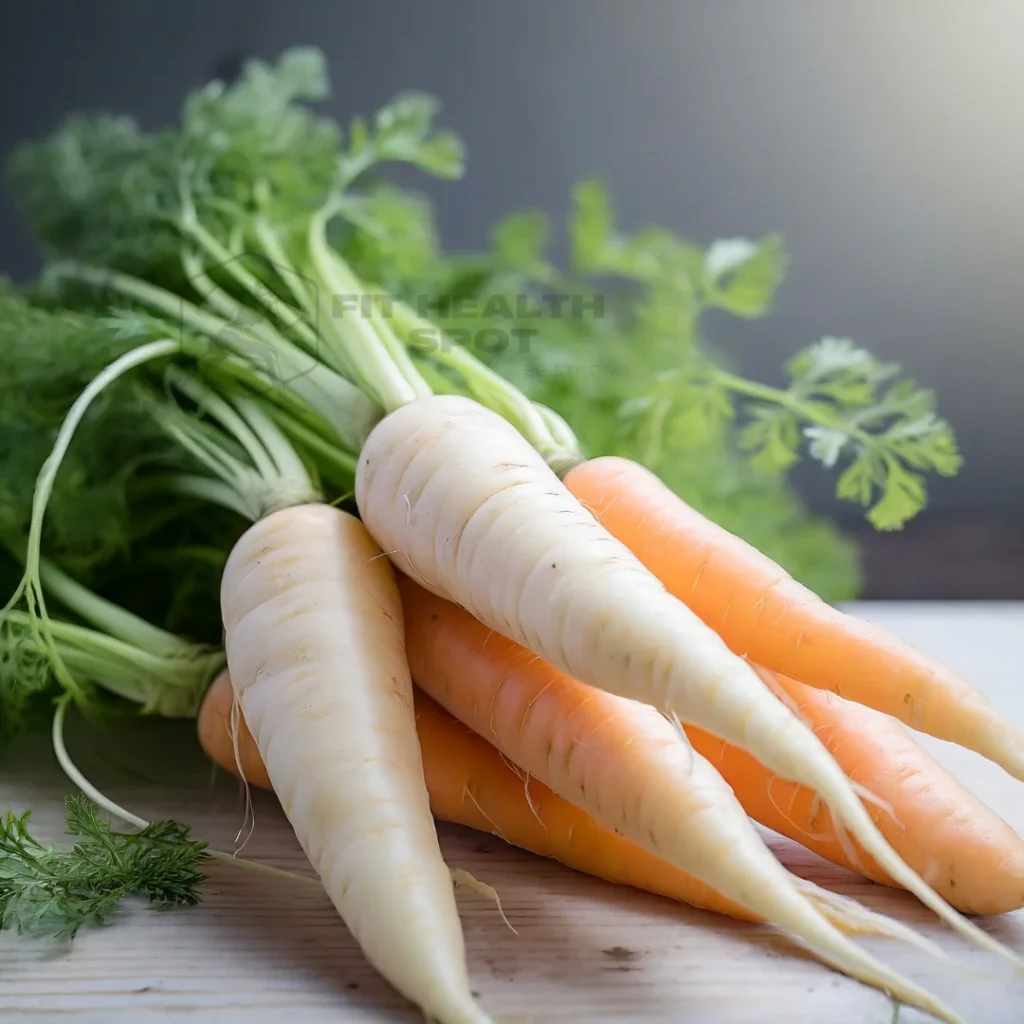
Unveiling the Uniqueness of White Carrots
At first glance, white carrots might be mistaken for other root vegetables like parsnips, but they hold their own identity. Pale in color and often overshadowed by more vibrant carrot varieties, white carrots are a treasure trove of flavors and nutrients. They offer a milder taste than other carrots, making them a versatile ingredient in various dishes. The satisfying crunch of white carrots enhances salads and can contribute nutrition to soups and stews. In the forthcoming parts of this blog, we will explore various facets of white carrots, including their nutritional makeup, contrasts with parsnips, and their importance in sustaining a nutritious diet.
White Carrot Benefits: Nutritional Profile
Unveiling the Nutritious Benefits of White Carrots
White carrots, a unique variant in the carrot family, offer numerous nutritional benefits that are often overlooked. These pale-colored roots are not just visually distinctive; they store health-boosting nutrients. In this section, we dive deep into the nutritional essence of white carrots and compare their benefits with other carrot varieties.
A Closer Look at the Nutrients in White Carrots
Dietary Fiber: White carrots are an excellent dietary fiber source, essential for maintaining good digestive health. Fiber facilitates the digestive process and plays a role in maintaining balanced blood sugar levels.
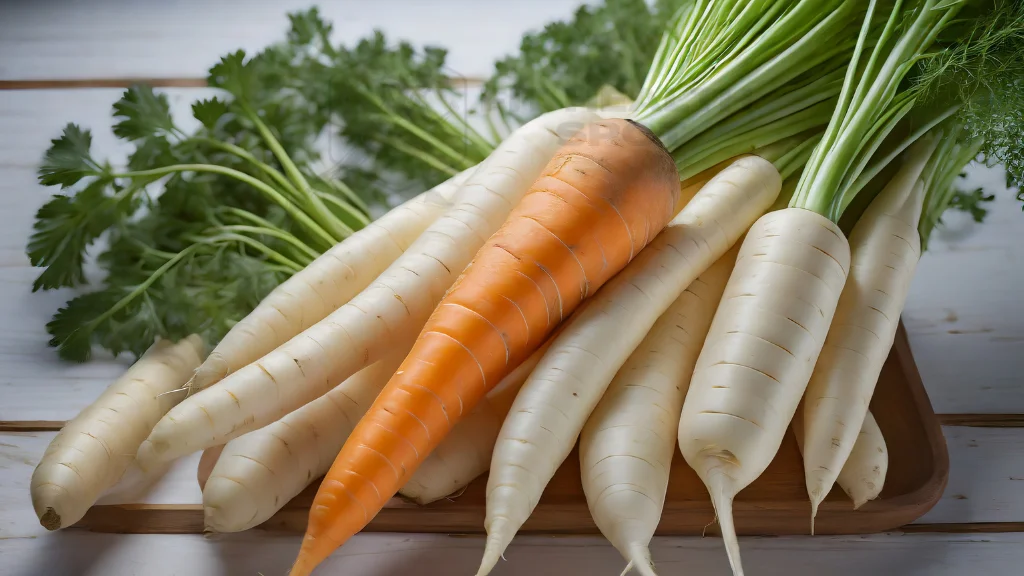
Vitamins:
Vitamin A: Essential for preserving good eyesight and a robust immune system.
Vitamin C: Renowned for its antioxidant characteristics, it is crucial in maintaining skin well-being and supporting the immune system.
Vitamin K: Crucial for both blood clotting and maintaining bone health.
Minerals:
Potassium: Crucial for the well-being of the heart and the proper functioning of muscles.
Comparing White Carrots with Other Varieties
While white carrots do not contain the beta-carotene found in orange carrots, which is converted into Vitamin A in the body, they compensate with their own unique set of nutrients. Notably, white carrots are rich in phytonutrients like falcarinol and falcarinol, which have been studied for their potential anti-cancer properties. This distinct nutritional composition makes white carrots valuable to a balanced diet.
In the realm of root vegetables, each variety brings its unique set of benefits. For instance, like white carrots, shallots offer a range of health benefits. They are celebrated for their anti-inflammatory properties and contributions to heart health. To delve deeper into the benefits of shallots, consider reading this insightful article on the health benefits and culinary uses of shallots.
In summary, white carrots are more than just a novelty; they are nutrient-rich vegetables that deserve recognition in the healthy diet spectrum. Their inclusion in your diet, whether in raw form, roasted or as part of soups and stews, adds a unique flavor and a wealth of health benefits.
White Carrots vs Parsnips: Understanding the Differences
Delving into the Distinctive Qualities of White Carrots and Parsnips
Often mistaken for one another, white carrots and parsnips are distinct root vegetables with unique characteristics. While they share some similarities in appearance and culinary use, their differences regarding taste, nutritional value, and cooking applications are significant. Let’s explore these differences in detail.
Visual and Taste Distinctions
Appearance:
White Carrots: White carrots resemble the traditional carrot in shape but are pale in color. They have a smooth texture and are slightly less tapered than orange carrots.
Parsnips: Parsnips are similar in color but tend to be thicker, more rounded, and have a more pronounced tapering. Their skin is often more textured than that of white carrots.
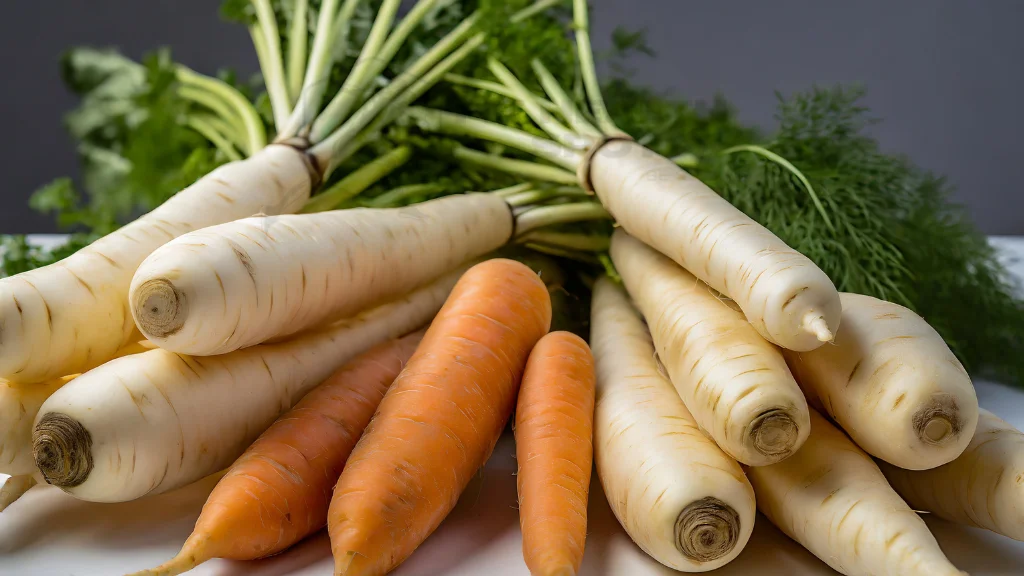
Taste Profile:
White Carrots: They have a mild, slightly sweet flavor and crisp texture. This subtlety makes them versatile in both raw and cooked forms.
Parsnips: Parsnips are sweeter and have a nuttier and slightly spicy flavor, especially when cooked. Their sweetness intensifies with roasting, making them ideal for hearty dishes.
Nutritional Differences
White Carrots:
Rich in dietary fiber.
Contains vitamins A, C, and K.
Lower in sugar compared to parsnips.
Parsnips:
Higher in sugars and carbohydrates.
Good source of folate and potassium.
Contains antioxidants and essential minerals.
Understanding these differences is key to utilizing each vegetable to its fullest potential in cooking and nutrition.
In the context of nutritious root vegetables, it’s interesting to compare white carrots and parsnips with another staple: garlic. Garlic is well-known for its positive effects on heart health and immunity, contributing to its reputation for being beneficial to overall well-being. To discover more about the health advantages of garlic, check out this comprehensive guide on the health benefits of garlic cloves.
In conclusion, while white carrots and parsnips may look similar, they each bring unique flavors and nutritional profiles. Understanding these differences can enhance your culinary experiences and influence your dietary choices.
Culinary Uses of White Carrots
Enhancing Your Meals with the Mild Flavor of White Carrots
The understated elegance of white carrots lies not only in their unique appearance but also in their culinary versatility. These pale roots can transform ordinary dishes into something extraordinary with their subtle sweetness and crisp texture. Let’s dive into some creative ways to use white carrots in your kitchen and explore a range of recipes that showcase their versatility.
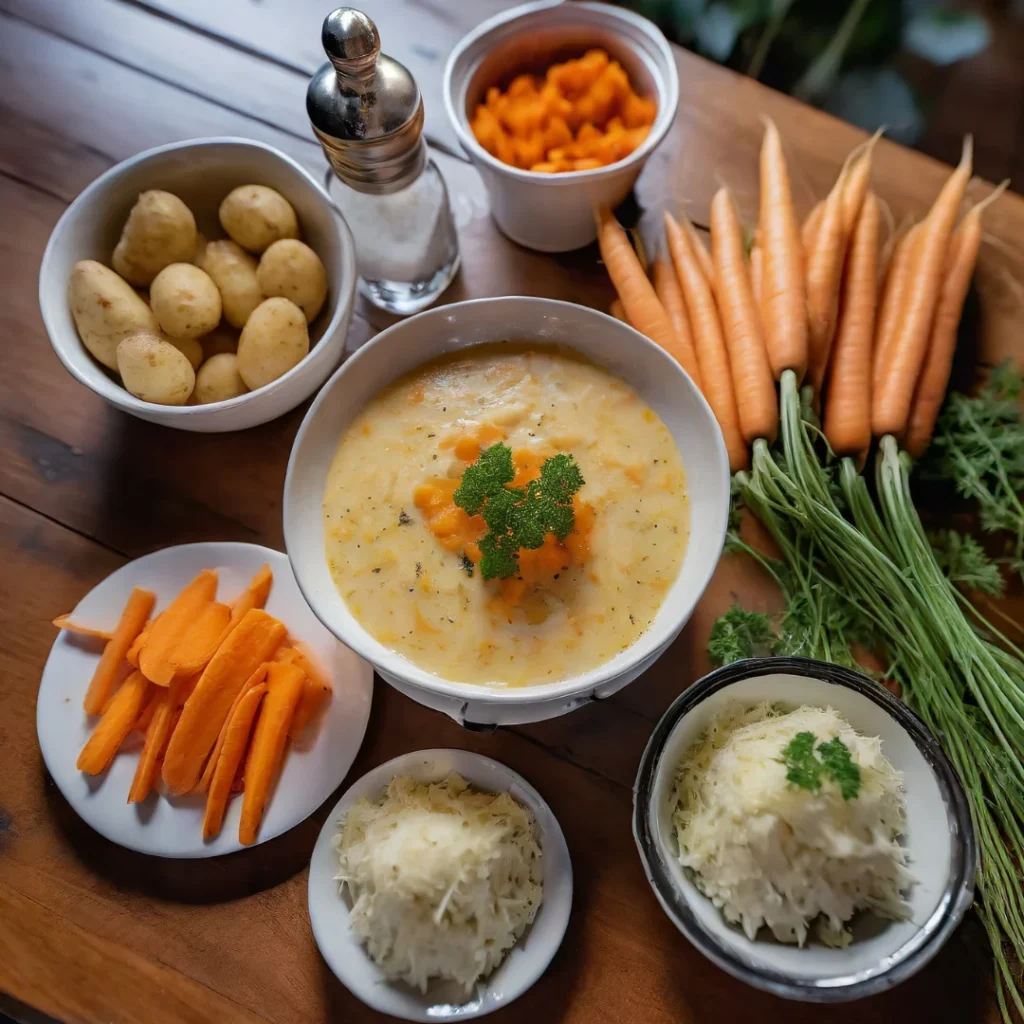
Innovative Recipes with White Carrots
Creamy White Carrot and Ginger Soup:
This comforting blend, ideal for any season, combines the subtle taste of white carrots with the warmth of ginger.
Crispy Roasted White Carrot Salad:
Combine roasted white carrots with greens, nuts, and a light dressing for a flavorful and texturally diverse salad.
Refreshing White Carrot Coleslaw:
A new take on coleslaw featuring shredded white carrots, cabbage, a creamy dressing, and fresh herbs for an added zing.
Savory White Carrot Risotto:
Stir finely chopped white carrots into your risotto for an extra layer of flavor and a delightful crunch.
Incorporating White Carrots in Daily Cooking
Versatile Side Dish: White carrots can be roasted, steamed, or sautéed, making them an excellent side dish to complement various main courses.
Baking Delights: Add grated white carrots to muffins, cakes, or bread for a subtle flavor and moist texture.
Boost Your Smoothies: White carrots blend seamlessly into smoothies, offering a nutritious kick without overpowering other flavors.
Exploring More Root Vegetable Recipes
Root vegetables are a treasure trove of flavors and health benefits. If you’re the versatility of white carrots inspires you, you might also enjoy exploring recipes with sweet potatoes, another nutrient-rich and flavorful root vegetable. For a collection of sweet potato recipes that range from savory to sweet, check out this Sweet Potato Recipe Collection.
White carrots are a culinary gem that can brighten your meals with their unique flavor and texture. From hearty soups to refreshing salads, there are endless ways to incorporate them into your daily diet. So next time you’re in the kitchen, consider reaching for these pale beauties to add a touch of elegance to your cooking.
Exploring Look-alike Vegetables: What Vegetables Look Like a White Carrot?
Discovering the Doppelgängers of White Carrots in the Vegetable World
White carrots, with their unique appearance, can often be confused with other root vegetables. This section identifies those vegetables resembling white carrots and highlights their distinctive features. Understanding these differences not only aids in proper identification but also enriches our knowledge of the diverse world of vegetables.
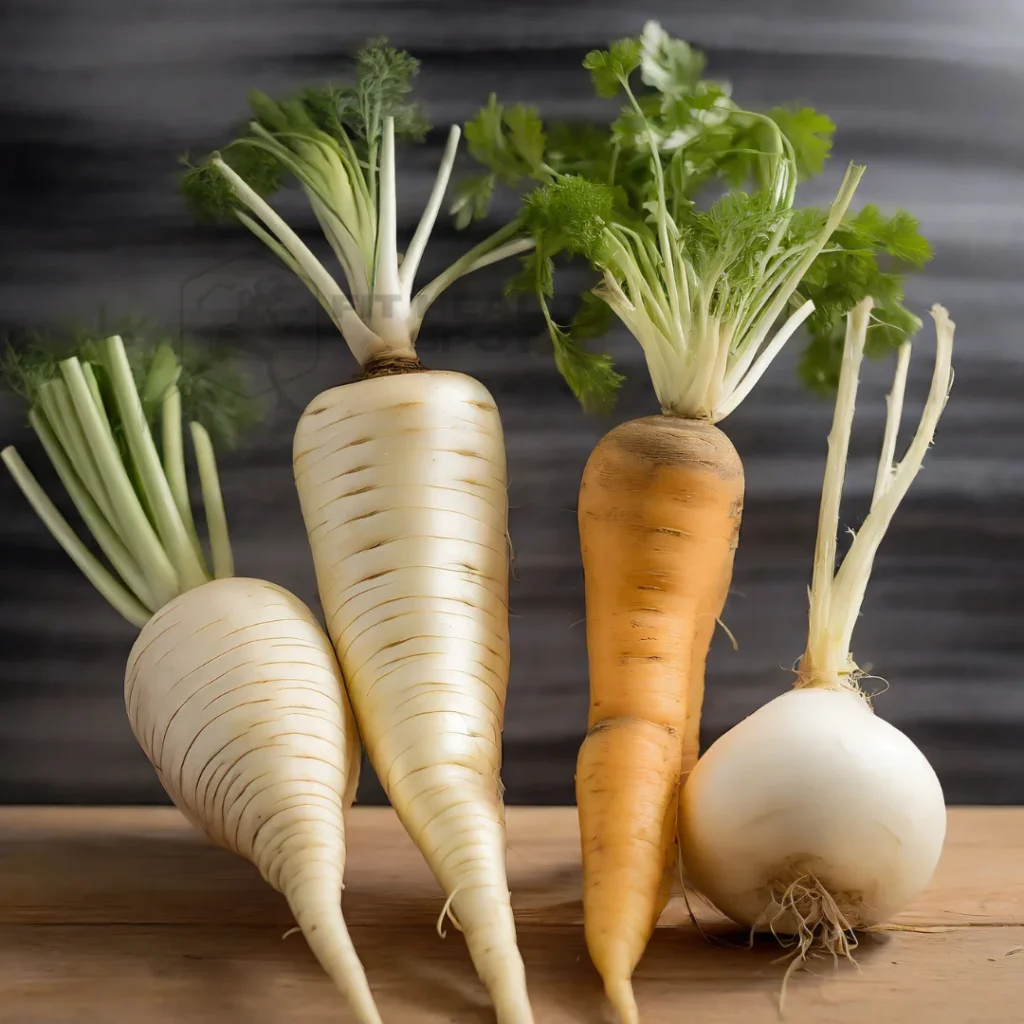
Vegetables Similar to White Carrots
Parsnips:
Appearance: Thicker and more rounded than white carrots, with a more textured skin. · Taste: Sweeter and nuttier, especially when cooked.
Daikon Radishes:
Appearance: Larger and more cylindrical than white carrots, often with a smoother texture.
Taste: Milder and less sweet, with a slight peppery undertone.
Celeriac (Celery Root):
Appearance: Knobby and rough-skinned, celeriac is less tapered and more globular.
Taste: A subtle celery-like flavor, earthy and nutty.
Distinguishing Features of These Vegetables
Each of these vegetables, while similar in appearance to white carrots, brings its own unique set of characteristics:
Parsnips: Known for their creaminess when cooked, ideal for purees and soups.
Daikon Radishes: Popular in Asian cuisine, they are often pickled, stir-fried, or served raw in salads.
Celeriac: A versatile root that can be mashed, roasted, or used in soups and stews.
Exploring More Uncommon Vegetables
The vegetable kingdom is full of unique and less common choices, each offering its own set of flavors and health benefits. For instance, while not a look-alike, green papaya is another example of an uncommon vegetable with various culinary uses. To learn more about green papaya, including its health benefits and culinary applications, delve into this comprehensive guide on green papaya.
In conclusion, while white carrots have their look-alikes, each of these vegetables has distinct features and culinary uses. Recognizing these differences not only aids in selection and preparation but also opens up a world of diverse and exciting cooking possibilities.
Growing White Carrots: A Gardener’s Gardener’s Guide
Cultivating Your White Carrots: A Step-by-Step Journey
Growing white carrots in your garden can be a rewarding experience. Not only do you get to enjoy the taste of fresh, home-grown produce, but you also gain the satisfaction of nurturing these unique vegetables from seed to harvest. This manual will guide you through cultivating white carrots, providing tips for achieving optimal growth and implementing efficient pest control measures.
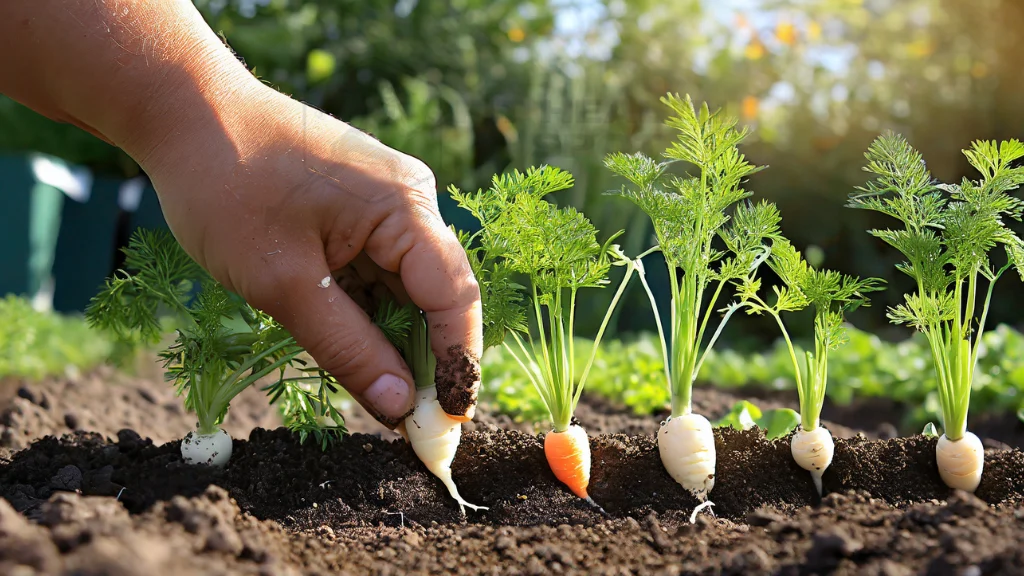
Step-by-Step Guide to Growing White Carrots
Choosing the Right Seeds:
Select high-quality white carrot seeds from a reputable supplier to ensure the best growth potential.
Preparing the Soil:
White carrots prefer loose, well-drained soil. Prepare your garden bed by cultivating the soil and eliminating rocks or compacted clumps.
Sowing the Seeds:
Plant the seeds in rows about ¼ inch deep. Ensure the rows are spaced adequately to allow for growth.
Regular Watering:
Maintain a consistently moist soil, avoiding excessive wetness. White carrots require frequent watering, particularly in periods of drought.
Thinning Seedlings:
When the seedlings reach a height of a few inches, thinning them is necessary to avoid overcrowding, as it may result in smaller carrots.
Monitoring Growth:
Keep an eye on your white carrots as they grow. They typically take about 50-60 days to mature.
Tips for Optimal Growth and Pest Control:
Sunlight: Ensure your white carrots receive sunlight at least 6-8 hours daily.
Fertilization: Use a balanced fertilizer to provide essential nutrients.
Pest Control: Watch for common pests like carrot flies. Using row covers can help protect your carrots.
Harvesting: Harvest white carrots when they reach your desired size. Gentle pulling or loosening the soil around the carrot can make harvesting easier.
Expanding Your Gardening Horizons
As you delve into growing white carrots, why not explore other interesting and unique gardening ventures? For example, corn nuts, not a vegetable but a crunchy snack made from corn, have an intriguing cultivation and processing story. To learn more about the process of creating corn nuts, from the field to your snack bowl, check out this informative guide on corn nuts.
In conclusion, growing white carrots can be a delightful addition to gardening activities. By adhering to these steps and suggestions, you can relish the rewards of your efforts with a plentiful yield of fresh, healthy white carrots. Whether you’re an experienced gardener or a beginner, cultivating white carrots assures a satisfying experience.
Conclusion: Unveiling the Wonders of White Carrots
A Journey Backed by Research and Expertise
Our exploration into the world of white carrots has been a journey of discovery, blending professional research with expert consultation. This thorough manual has been constructed to offer dependable, extensively researched information. From uncovering the nutritional prowess of white carrots to diving into their diverse culinary uses and providing detailed gardening tips, each segment of this guide is rooted in thorough research and consultation with industry experts.
Summarizing Our White Carrot Exploration
Nutritional Powerhouse:
We’ve highlighted the significant health benefits of white carrots, emphasizing their rich nutritional content.
Culinary Creativity:
The various recipes and cooking tips explored here showcase the versatility of white carrots in gastronomy.
Gardening Insights:
Our detailed gardening guide offers practical advice for those looking to grow white carrots, reinforcing the joys of home gardening.
Engaging with Our Readers: Your Thoughts Matter
We Value Your Engagement
This comprehensive guide on white carrots aims to be more than just a source of information—it’s an invitation for interaction and community building.
Share Your White Carrot Experiences: Have you experimented with or cultivated any of our white carrot recipes in your garden? Your stories and experiences are eagerly awaited.
Inquiries and Further Discussion: Should you have any queries or seek additional advice, don’t hesitate to reach out. Our platform is an open space for dialogue and assistance.
Feedback and Future Topics: Your insights are crucial to us. Share your thoughts on this guide and suggest other topics you’d like us to explore.
Looking Forward to Your Contributions
As we continue to delve into healthy living and gardening, we invite you to join this journey of collective learning and sharing. Your participation is key to nurturing a community passionate about health, nutrition, and the joy of gardening.
Thank you for being a part of our exploration into the unique world of white carrots. We eagerly await your engagement and feedback. Stay connected for more insightful content from FitHealthSpot, where knowledge and passion for healthy living come together.
Frequently Asked Questions About White Carrots
Your Curiosities Addressed
Several questions have arisen in our journey exploring the intriguing world of white carrots. Here, we address some of the most frequently asked questions, providing clarity and further insight into this unique vegetable.
We hope these answers help clear up any uncertainties and enhance your understanding and appreciation of white carrots. If you have more questions, feel free to reach out, and we’ll be happy to delve deeper into the world of this fascinating vegetable.
